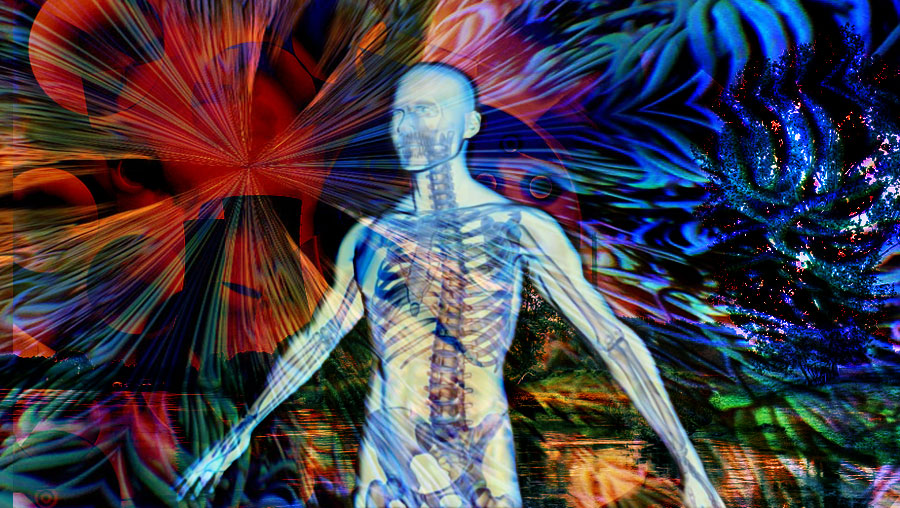Atomic Radiation And Its Effects On Living Tissue
 by Jack Schubert, Ph.D. And Ralph E. Lapp, Ph.D.
by Jack Schubert, Ph.D. And Ralph E. Lapp, Ph.D.
As atomic radiations rip through living tissues they disrupt the highly organized unit of living matter, the cell. Fundamentally, the cell is composed of atoms and molecules which are split by radiation into electrically charged fragments. This ionization process is completed in less than a trillionth of a second, yet it triggers off a chain reaction of subtle events within the cell leading to its damage or death even years afterward. Since cells are not inert blobs of matter but living, reproducing, miniature organisms, they react to the radiation-induced injury by repair processes which lead to apparent recovery. If the radiation dose is overwhelming, immediate or only slightly delayed death of the cell ensues when the cell attempts to divide.
How does radiation damage to cells lead to injury of man himself? What is the relation between radiation dose and radiation injury? What are the effects produced by radiation on living matter? How can we prevent or cure the injuries produced by radiation? These are questions which we must examine if we are (1) to understand the significance of the actions of radiation on the human body; (2) to evaluate more accurately the misuses of radiation in peacetime; and (3) to make it possible for the public to appreciate the urgent need for regulations and laws to control radiation hazards.
One fact which must be appreciated at the outset is that any kind of ionizing radiation—whether alpha rays, beta rays, gamma rays, neutrons, cosmic rays, or others—produces the same effects on cells and organs. It makes no difference either whether the radiation is produced by an x-ray machine, fluoroscope, cyclotron, or by a radioactive isotope embedded in the tissue. There is nothing unique about any one type of ionizing radiation as to the kind of effect produced, although there is in some cases a difference in the dose required to produce a certain degree of effect under the same conditions. Also, heavy particles like the alpha rays are more likely to make direct hits on all constituents. Despite the fact that much of our information on the biological effects of radiation comes from x-rays, we can apply the results to all other types of ionizing radiation by suitable adjustment of dosage. If we seem to belabor this point it is because we continually encounter assertions that beta radiation is safe but gamma is not; or that radiations delivered to a tissue by a radioactive isotope are harmless but that x-rays delivered to the same tissue produce injury, and so on. Such misconceptions in medical practice have caused numerous individuals to suffer radiation burns and injuries.
The fundamental effects of radiation begin with the cell. It is here that the ultimate demonstration of how radiation acts on living matter must be found. Cells themselves, despite enormous differences in their sizes, shapes, and functions, are constructed according to a master plan. Surrounded by a nearly invisible skin or membrane, they are filled with a gelatinous material (cytoplasm) in which is suspended a smaller but very distinctive particle, the nucleus, which is conveniently bounded by its own membrane. The nucleus is the heart of the cell, and contains a tangled network of threadlike material—the chromosomes—which can be seen under the microscope.
The chromosomes in human sex cells are the physical carriers of the minute specks of matter which preserve our hereditary makeup—the genes. The genes are too small to be seen under the microscope but their existence, functions, and arrangement are deducible from genetical experiments, just as the existence and properties of molecules are deduced from physical experiments. The genes are strung single-file along the chromosome. For our present discussion it is sufficient to appreciate the fact that each one of the thousands of genes has its own unique function in regulating the complicated series of unceasing chemical reactions necessary to maintain life.
Exposure of the body to the maximum permissible dose of radiation, 0.3 r per week, directly disrupts about 300 molecules in each of the 140 trillion cells in the human body. A dose of 1000 r, which would kill a human being, directly disturbs only about one molecule in 10 million. Obviously, the changes induced among these relatively few molecules must become enormously amplified. How does this amplification or multiplication process get started? While no one can as yet give a detailed answer, the general pattern of radiation damage to cells is well understood. The cells in the body are mainly water, and it is in this water that the primary effects of radiation take place.
When water in the cell is acted upon by radiation, a small fraction is decomposed into extremely reactive fragments called free radicals, which readily interact to form peroxides and other cell poisons. These peroxides, as well as many other decomposition products, can move around for a short while until they alter a receptive molecule. Among the most sensitive substances in the cell are enzymes, which are essentially large protein molecules. One enzyme molecule modified by radiation may transform 100,000 or more molecules needed for perpetuation of the metabolic activities of the cell. Consequently we have here one of the necessary amplification or multiplication mechanisms for transforming a relatively small radiation effect into an eventual observable injury to the cell.
Sometimes the ionization path passes directly through a chromosome. Actual breakage of chromosomes has been observed when the ionizing radiation has hit them head-on. Direct hits are more likely from heavy particles such as alpha rays and neutrons.
Radiation also harms cells by producing changes in the environment. Cells are bathed by solutions from which radiation-produced activated products can reach and damage them. Also, cells can be damaged by interference with their blood supply and the action of poisonous products released by radiation-killed cells themselves.
Since tissues are a specialized population of cells, their exposure to radiation causes damage as a consequence of injury and death of the component cells. The over-all effect involves not only the direct action of the radiation on the individual cells but changes in the surroundings of the tissue. For example, the production of a type of scar tissue is characteristic when the tissue becomes “starved” because of radiation interference with its blood supply. However, it takes very large doses of radiation, about 1000 r, to cause serious effects on the blood supply to tissues.
As we have shown, tissues vary greatly in their radiosensitivity. These differences are not absolute or completely well defined, but in general, rapidly growing tissues, and those dependent on a generous blood supply seem to be most radiosensitive. Consequently the most radiosensitive organs include the blood-forming organs such as the bone marrow and spleen, and reproductive tissues, while the next most radiosensitive are the skin, growing bone, and the linings of blood vessels and the stomach and intestines. One tissue may give an immediate response to radiation and another no apparent or detectable response. However, the seemingly unresponsive tissue may show injury at a much later date. The recovery of tissues from immediate radiation injury depends on the specific cell types, or the size of the radiation dose, and on the time between repeated irradiations. These factors have been well summarized by Doctors E.G. Williams and S.C. Ingraham II in a United States Public Health report for 1956:
“The blood forming organs, the skin, the membranes lining body cavities, and the secreting glands may regenerate completely and resume their normal functions. Muscle, brain, and portions of the kidney and eye cannot regenerate; repair of them results only in scar formation. Even those tissues that can regenerate may fail to respond after repeated ionization and so cause conditions such a s non-healing ulcers or aplastic anemia (bone marrow destruction). Also, repeated regeneration may produce cancerous conditions.
“. . . These changes have all been observed in animals following radiation exposures at levels corresponding to doses only slightly above the accepted safe limits for man. There are no constant clinical symptoms which can be relied upon to warn of latent radiation injury before the late changes become manifest.”
With respect to immediate observable effects of radiation, the response of tissues depends very much on the rate of delivery of the radiation. A good analogy can be drawn with the effects of ultra-violet light from the sun in producing sunburn. Every sunbather knows that the burning effect of the sun depends both on the brightness of the sunshine and the length of exposure to it. Similarly, the short-range effects of radiation from such sources as gamma rays, x-rays, or beta rays are dependent on the intensity of the radiation and period of exposure.
A very well studied tissue in respect to the effect of divided radiation doses is the skin. After the doses of radiation discussed here, the reddening effect of the radiation would reach its height about 3 weeks after irradiation. In the radiation field this can be considered an immediate effect. If, for a given quality of x-rays, it takes 700 r delivered in 1 hour to redden the skin, it is found that in order to produce the same effect with two divided radiation doses given 24 hours apart, it is necessary that each dose be 535 r, making a total of 1070 r. Obviously, in the 24-hour period following the first dose some degree of recovery of the tissue took place. While 700 r may produce a reddening effect if given at once, no apparent changes will take place if the same dose is divided into 30 small doses over a month. In order to get a reddening with 30 separate does, a total dose of radiation of nearly 2000 r would be needed. Radiologists in actual practice make use of charts for different tissues which show how much radiation must be given to produce a given effect, depending on the time elapsed between doses. Rates of recovery differ widely for different tissues, so different charts of treatment must be made for each specific tissue.
One of the most characteristic biological manifestations of radiation is the delay between the exposure of an organism and the appearance of the radiation-induced changes. While the length of the delay—called the latent period—depends on the specific tissue and other biological factors, the single most important factor is the size of the radiation dose. In general, the larger the dose, the earlier the appearance of injury. However, for the very long-delayed effects, including cancer, the relationship between dose and time of appearance of symptoms is not as well characterized, but, in general, seems to depend only on the total accumulated dose.
The longest known period between a single large exposure of radiation and the appearance of a cancer was reported in England in 1955 by Doctors J.S. Mitchell and J.L. Haybittle.
The patient was a woman aged 70 when first seen in 1948. In 1898 she had received an estimated 1500 r dose of radiation during a 1-hour fluoroscopy examination for the purpose of revealing kidney stones. A “burn” over the right upper abdomen appeared about two weeks after the exposure to the x-rays, but subsequently healed. In 1947 there developed a typical skin cancer in the region which had been irradiated 49 years earlier. She died in 1949 from the uncontrolled spread of cancer.
What does all this mean in the practical sense when we speak of radiation injury to man? It means that no cell fully recovers from a dose of radiation. While a cell may seem to recover, there is an irreversible effect on the chromosomes and genes. Usually one thinks of genetics in terms of the cells which deal with reproduction, but the cells of our tissues also have the same capacity to remember past events and to “bear offspring” of new cells. As is the case with hereditary traits, these somatic mutations may take many generations of a given cell type to manifest themselves. So the mother cells of the skin, for example, which live about four months, may eventually give rise to abnormal or defective cells. The latter may produce the cancers, wartlike growths, or ulcerative tissues of a year, ten years, or even fifty years later, depending on the total radiation dose received and the particular tissues involved.
The situation has been well summarized by Doctors Williams and Ingraham in the paper already mentioned.
“Ionizing radiation can alter genes in the body (somatic) cells and in the reproductive (sexual) cells and so cause them to grow or reproduce abnormally. If a gene change occurs in a sexual cell, a mutation will occur in later generations provided that the cell is used in reproduction. If a gene change occurs in a cell of growing or regenerating somatic tissue like skin, liver, or bone marrow, it may cause cancerous or other harmful changes in the exposed individual.”
It has been known for several decades that radiation damage to chromosomes accounts for aberrations in later generations of sexual cells. It is also the principal fact which explains the many observations of delayed effects in tissues, following irradiation. This is a reasonable deduction when it is considered that all cells have chromosomes and genes capable of mutations. At the 1955 Geneva Conference one of the most esteemed experts in the field of genetics, Professor H.J. Muller, flatly stated:
“It may happen that a mutation is of such a type that it confers upon the subject cell and its descendants the property of more rapid growth than neighboring cells. Such cells may multiply rapidly, apparently not deterred by influences which inhibit the growth of neighboring cells, and as a result the continuing growth becomes abnormal and is classed as cancerous or malignant tumor. Where white blood cells are involved the abnormality is called leukemia.”
It is unpleasant to contemplate that the delayed effects of radiation on tissues reflect somatic mutation because it means that all amounts of radiation above the normal background increase the probability of late harmful effects. Radiation’s role in increasing the likelihood of a cancer may, according to some scientists, depend on the accumulation of a minimum dose of radiation (the so-called threshold dose) of roughly 1000 rad for alpha radiation and somewhat more for x-ray and beta radiation. This opinion was reported by Professor R.D. Evans of the Massachusetts Institute of Technology in 1947 at the Fourth International Cancer Congress on the basis of information from (1) cases of known bone cancer in humans who had stored radium in the body; (2) patients who had received x-ray doses to the bone; and (3) uranium miners who developed lung cancer as a result of breathing the radioactive gas radon. However, as more critical observations are made it will undoubtedly be found that no real threshold dose exists. Within the past few years, for example, it has been found that thyroid cancer in children has been induced by as little as 200 r of radiation delivered to the neck region—an observation so important that further checks on its validity must be obtained. As a matter of fact, there may be no threshold effect at all if observations are made over a long enough period of time. For example, in an average case, a 1000 r dose may not produce a cancer in 20 years, but may consistently do so in 50 years. In the light of recent data provided by the careful examination of patients who have less than the present-day maximum permissible levels of radium in their bones but who nonetheless exhibit bone lesions, we feel that the concept of a threshold for radiation injury is probably wrong. Any radiation produces some biological effect, which would be demonstrated if our methods of assay were sensitive enough to detect it.
See Part II here, Part III here.
Posted in Other Topicswith 2 comments.






Sobering words in view of the power of Sociopathic politics worldwide !…Will this be the source of the next great disruption and distruction, and birth of the next higher race of humanity ?
David, if you go to http://www.unariunwisdom.com/ufonauts-on-the-dangers-of-nuclear-energy-war/ then scroll down to the EBE interview, he is implying just this thing, though I don’t think it is a higher race but a lower downhill slow evolutionary descent likely into disintegration. The earth is a place for the kind that exists here, the murderers, psychopaths, etc. They had to have some place to incarnate and here it is and here we are with them until we learn to move spiritually forward to the next level in our evolution. The works of Ernest L. Norman, in my opinion, provide one of the best starting points if not the best in that direction. Learning about the true nature of reality is the way to go and that is why he called his works the UNiversal ARticulate Interdimensional Understanding of Science.